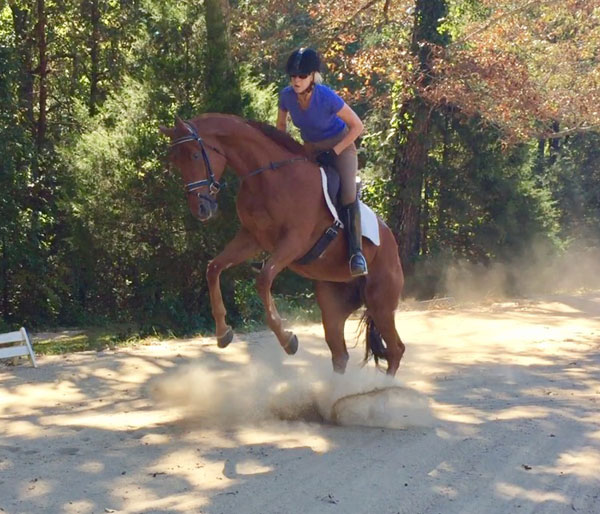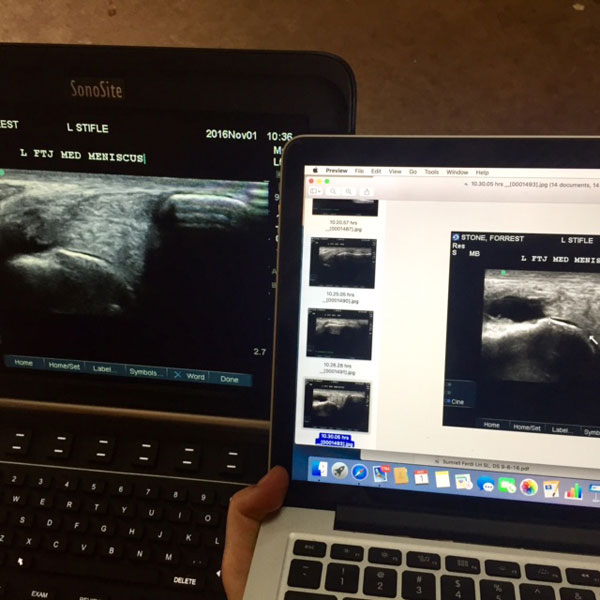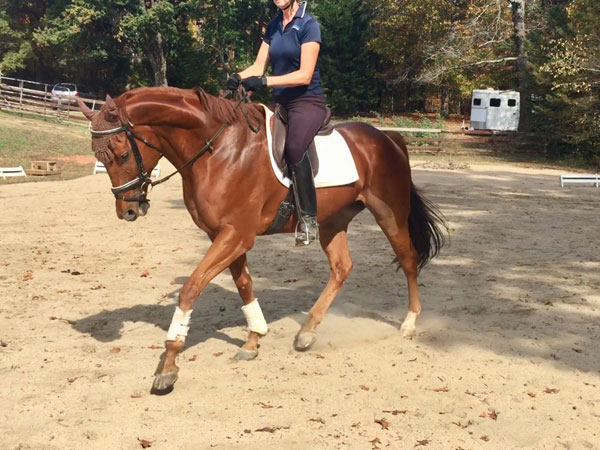That title is actually slightly misleading. Hang with me a few moments and I’ll explain why.
When Dr. Gillis returned for Forrest’s regular, 8-week ultrasound, I was frankly dreading it. Why? Because while Forrest had been very good for much of the last two months, he had had four explosive episodes in the rehab paddock before I could grab him and bring him back in. He’s a funny horse: he appears very mellow and laid back as he is led out and I think, Great, he’s going to be nice and relaxed. And he is, as he eats his breakfast al fresco. Then every now and then, he catches glimpse of, as Carl Hester named the spook during his first test in Rio, a Pokeman, and just turns inside out. His paddock is tiny but he can still twist and shout in there as I rush through the gate to grab him. “Why don’t you ‘ace’ him, Pam?” I can hear you ask. Because he also had two, violent gas colics, back to back, within four days of each other so now I’m too paranoid to slow down his gut and give him any more.
So what to do? I decided to gather an arsenal of supplements and calming agents.
I had to find an effective way to keep this young OTTB, now on his ninth month of stall rest, quiet without long-term sedation. I had been using transdermal magnesium oil, from Mg12, on my own body, after having my surgeon recommend it for reducing inflammation and pain from my broken wrist. He also told me that applying magnesium oil topically was far more effective than taking an oral supplement. The bio-availability means that soaking in the salts or rubbing it on allows 80 percent absorption into the body as opposed to only 20 percent when taken by mouth. And as a woman who suffers with insomnia and a few horse-related aches and pains, let me tell you, after taking a 40-minute soak and then applying the oil, not only did I sleep like a baby, my body was so loose that I felt as if I’d had a massage. So what dressage rider isn’t then going to think, Hmm, wonder if this would work on my horse? I applied the oil and balm to Forrest’s entire stifle region, over his croup, his heart area and just behind either side of his poll and I personally witnessed my horse begin to relax in the cross ties, and not only was he perfect in his turn out, when I tacked him up for our 30-minute walk under saddle, not only did we not have a single spook, he started out looser than he ever has and was nicely focused. The oil is simply “magnesium chloride, imported from the Dead Sea in Israel, along with naturally occurring trace minerals” according to the label, and I now use it on every horse that comes into my barn with the same results–not because they all need to be calmer but because the magnesium is also a vasodilator and opens blood vessels, drawing blood to tight muscles and, in Forrest’s case, injured soft tissue. And for me, I was over the moon to find it has completely stopped my Raynaud’s syndrome (white, painful fingers from cold temps due to spastic blood vessels). Winner, winner, chicken dinner!

Reading the clinical studies of GLC5000Rx supplement (because all these supplements claim to be effective but still can’t prove they make it past the g.i.tract) I was pretty impressed to see its addition of ‘actistatin’ improved bio-availability by 60 percent, so I decided to order it as well as the company’s probiotic, Pro Biostatin. And I will say that Forrest, who has had to have his grain cut way down, and not being an easy keeper, had been looking far too thin for my liking, suddenly appeared to be gaining weight on this probiotic, was comfortable being girthed and simply looked healthier all over. I’d had him on ulcer meds and I believe his gut is now far healthier with the Biostatin.
So, when Dr. Gillis arrived, I held my breath.
I had applied the Mg12 to Forrest and he was so relaxed and calm that as we began the ultrasound, for the first time, Forrest did not need to be sedated! I didn’t expect to see any improvement at all after his antics, but had certainly prayed and hoped that perhaps the GLC5000Rx might actually help as was claimed, and waited nervously as Dr. Gillis began to slide the probe over his affected area.
As you can see, that black, round, pocket of fluid stubbornly remains. But there was also encouraging news: ‘Left medial collateral ligament desmitis, moderate, generalized from origin to insertion is healing well.’ Yay! ‘Left medial patellar ligament desmitis, moderate, chronic, is healing normally; however, mild inflammation is seen at the origin.’ No surprise, there. ‘Medial and lateral menisci moderate fiber damage is healing; however frayed fibers are evident extending from the meniscal surfaces.’ Yep. ‘Left quadriceps mild fiber damage at insertion on the patella is nearly completely healed.’ Yay! ‘Comment: Meniscal fraying is likely causing the continued medial femora-tibial joint effusion.’ For you non vets out there: that’s that pocket of fluid on the ultrasound that looks like a horse’s eyeball.


Dr. Gillis’ recommends a series of IRAP injections or, if I can’t find a facility in which to do that, locally, Adequan or HA will give a good short-term result. And this is why we have been cleared for five minutes of trot after 20 minutes of walk, five alternate days per week to see if the added exercise helps strengthen this area or not. If not, Forrest would let us know immediately. But so far….so good.












